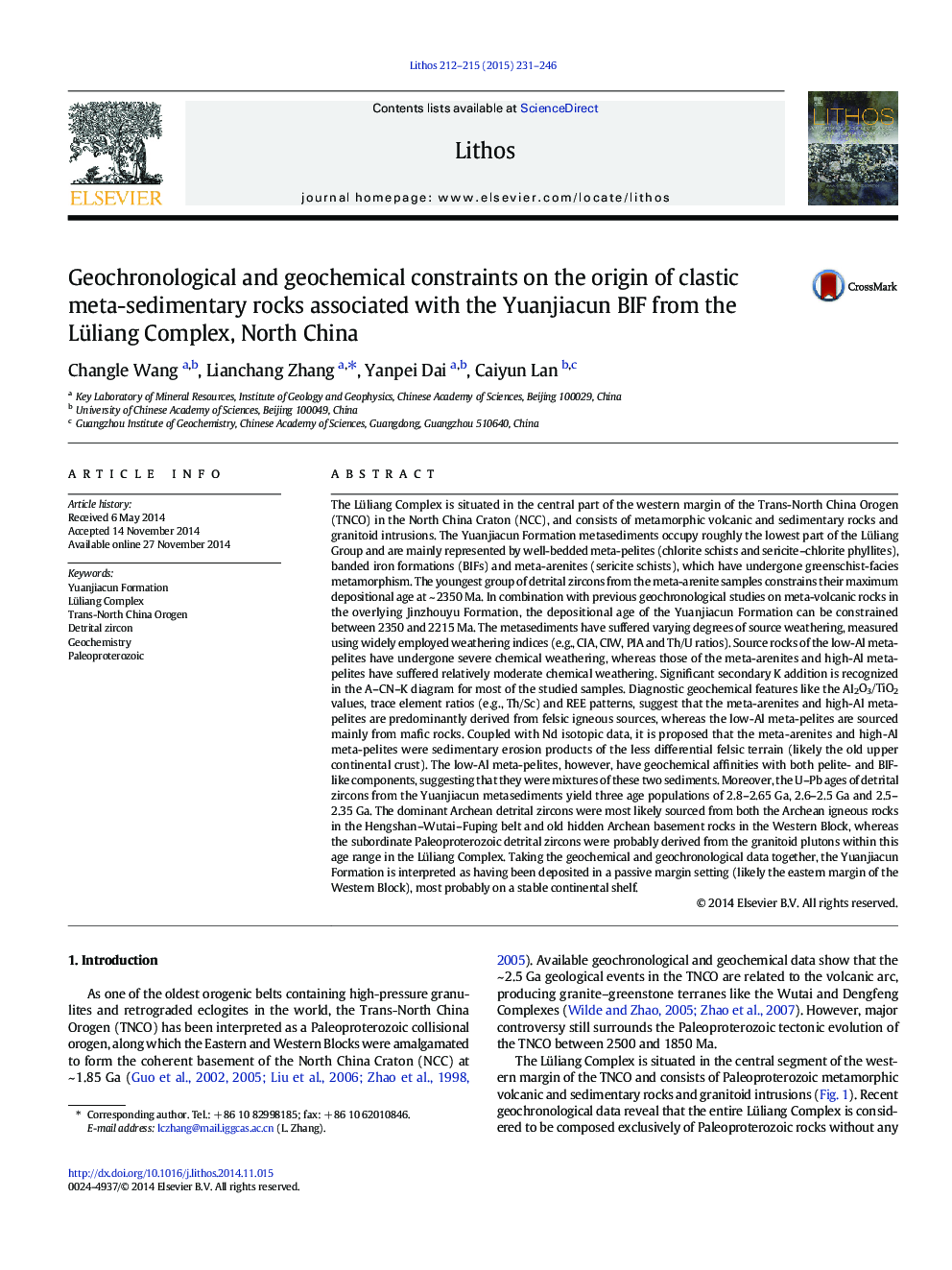| کد مقاله | کد نشریه | سال انتشار | مقاله انگلیسی | نسخه تمام متن |
|---|---|---|---|---|
| 4715798 | 1638669 | 2015 | 16 صفحه PDF | دانلود رایگان |

• The Yuanjiacun metasediments were deposited between 2350 and 2215 Ma.
• High-Al pelites and arenites are derived from a less differential felsic terrain.
• Major components are sourced from the Archean rocks in the Wutai area.
• Minor detritus are derived from the early Paleoproterozoic Lüliang granitoid plutons.
• The Yuanjiacun Formation formed in a passive margin setting.
The Lüliang Complex is situated in the central part of the western margin of the Trans-North China Orogen (TNCO) in the North China Craton (NCC), and consists of metamorphic volcanic and sedimentary rocks and granitoid intrusions. The Yuanjiacun Formation metasediments occupy roughly the lowest part of the Lüliang Group and are mainly represented by well-bedded meta-pelites (chlorite schists and sericite–chlorite phyllites), banded iron formations (BIFs) and meta-arenites (sericite schists), which have undergone greenschist-facies metamorphism. The youngest group of detrital zircons from the meta-arenite samples constrains their maximum depositional age at ~ 2350 Ma. In combination with previous geochronological studies on meta-volcanic rocks in the overlying Jinzhouyu Formation, the depositional age of the Yuanjiacun Formation can be constrained between 2350 and 2215 Ma. The metasediments have suffered varying degrees of source weathering, measured using widely employed weathering indices (e.g., CIA, CIW, PIA and Th/U ratios). Source rocks of the low-Al meta-pelites have undergone severe chemical weathering, whereas those of the meta-arenites and high-Al meta-pelites have suffered relatively moderate chemical weathering. Significant secondary K addition is recognized in the A–CN–K diagram for most of the studied samples. Diagnostic geochemical features like the Al2O3/TiO2 values, trace element ratios (e.g., Th/Sc) and REE patterns, suggest that the meta-arenites and high-Al meta-pelites are predominantly derived from felsic igneous sources, whereas the low-Al meta-pelites are sourced mainly from mafic rocks. Coupled with Nd isotopic data, it is proposed that the meta-arenites and high-Al meta-pelites were sedimentary erosion products of the less differential felsic terrain (likely the old upper continental crust). The low-Al meta-pelites, however, have geochemical affinities with both pelite- and BIF-like components, suggesting that they were mixtures of these two sediments. Moreover, the U–Pb ages of detrital zircons from the Yuanjiacun metasediments yield three age populations of 2.8–2.65 Ga, 2.6–2.5 Ga and 2.5–2.35 Ga. The dominant Archean detrital zircons were most likely sourced from both the Archean igneous rocks in the Hengshan–Wutai–Fuping belt and old hidden Archean basement rocks in the Western Block, whereas the subordinate Paleoproterozoic detrital zircons were probably derived from the granitoid plutons within this age range in the Lüliang Complex. Taking the geochemical and geochronological data together, the Yuanjiacun Formation is interpreted as having been deposited in a passive margin setting (likely the eastern margin of the Western Block), most probably on a stable continental shelf.
Journal: Lithos - Volumes 212–215, January 2015, Pages 231–246